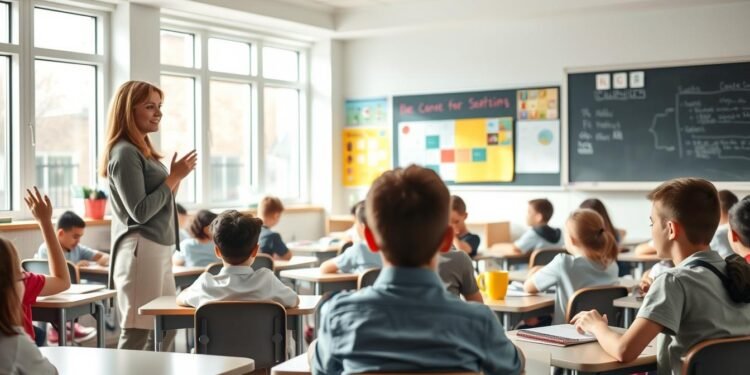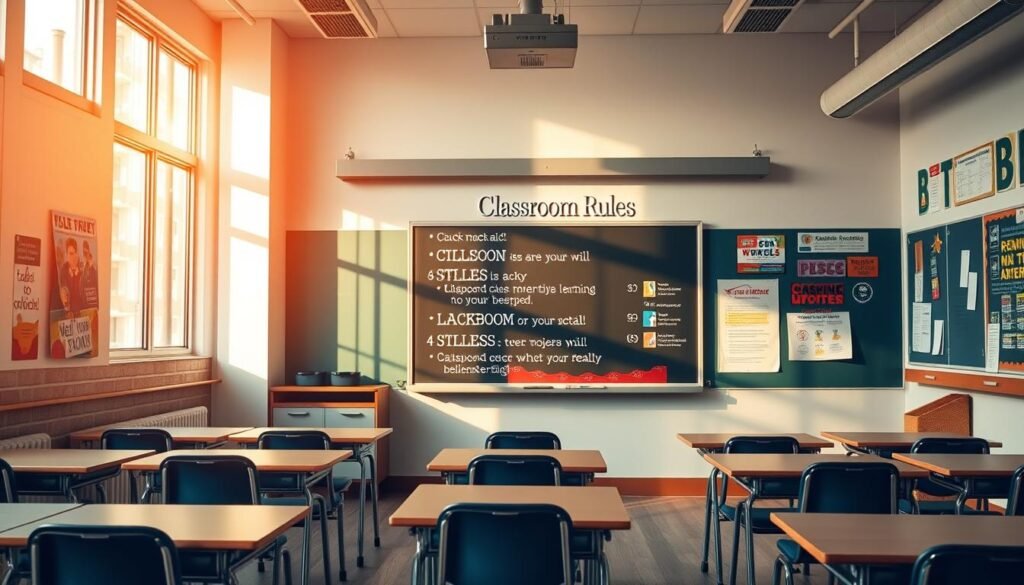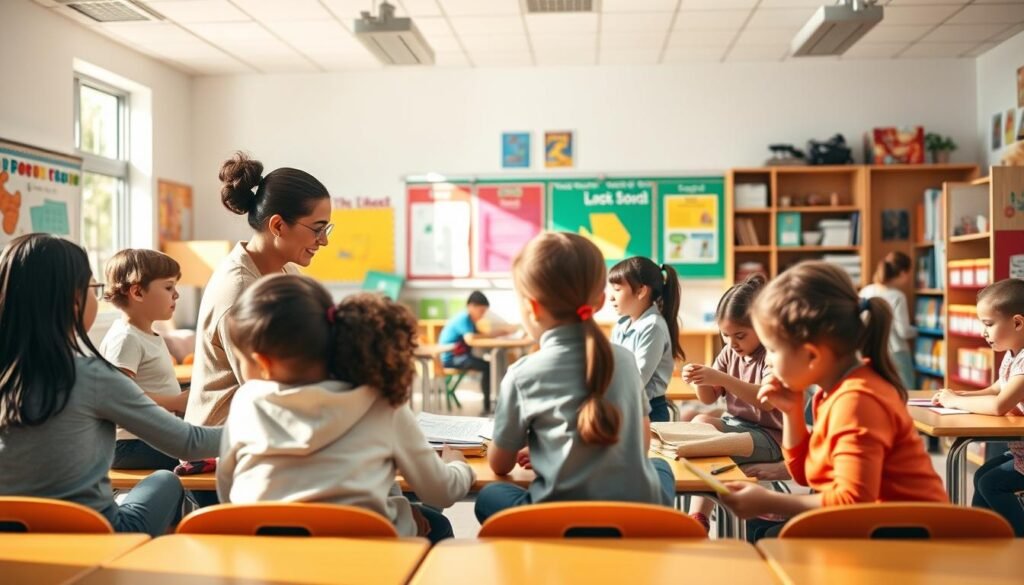Have you ever wondered why some educators seem to effortlessly maintain a positive and productive learning environment while others struggle? The secret lies in effective strategies that go beyond traditional methods. In today’s dynamic educational landscape, managing student interactions and fostering a structured setting is more critical than ever.
Creating a space where students feel safe and engaged is essential for their academic and social growth. Proactive approaches can transform challenges into opportunities, ensuring that every learner thrives. This article explores six evidence-based techniques to help educators build consistency, encourage positive reinforcement, and cultivate a supportive atmosphere.
With insights from recent studies and practical solutions, you’ll discover how to address modern classroom challenges. Whether you’re a seasoned teacher or new to the field, these strategies will empower you to create a harmonious and effective learning environment.
Key Takeaways
- Proactive strategies are essential for maintaining a positive learning environment.
- Effective management techniques improve both academic and social outcomes.
- Consistency and structure are key to fostering student engagement.
- Positive reinforcement encourages desired behaviors in students.
- Evidence-based approaches provide practical solutions for modern challenges.
1. Establish a Consistent Routine
Establishing a clear routine is a game-changer for both educators and learners. Predictable structures help students feel secure, reduce anxiety, and improve focus. When everyone knows what to expect, transitions become smoother, and disruptions are minimized.
Why Routines Matter
Routines provide neurological benefits, especially for adolescent brain development. Predictability helps students process information more efficiently and reduces stress. For example, visual schedules can cut transition time by 20%, allowing more focus on learning.
How to Create an Effective Schedule
Start by co-creating daily schedules with student input. This approach fosters ownership and ensures the routine meets their needs. Tools like ClassDojo can visually track progress, making it easier for everyone to follow. Incorporating non-verbal cues, like countdown timers, also prevents interruptions during lessons.
Involving Students in Routine Planning
Giving students a role in planning empowers them and encourages responsibility. A rotating jobs system, where disruptive students take on leadership tasks, can transform their engagement. For instance, a Virginia school reduced tardiness by 40% by letting students design their routines.
2. Set Clear Classroom Rules Together
When students take part in creating rules, they are more likely to follow them. Collaborative rule-setting fosters accountability and respect, leading to fewer disruptions and better focus. Research shows that involving students in this process reduces infractions by 73%.
The Importance of Student Involvement
Allowing students to help define expectations creates a sense of ownership. For example, a 5th-grade class reduced disruptions by 60% by using peer juries. A democratic process, like a “constitution” signing ceremony, can make rules feel more meaningful.
Enforcing Rules Fairly and Consistently
Consistency is key to maintaining trust. Neutral “behavior audits” with student representatives ensure fairness. A progressive discipline ladder, including restorative justice components, helps address issues constructively.
Handling Rule Infractions Effectively
Targeted interventions work better than whole-class punishments. Social contract agreements in secondary classrooms provide clear guidelines. Positive Action’s 4-year case study showed a significant reduction in suspensions by focusing on restorative practices.
3. Create Engaging and Stimulating Lessons
Engaging students in lessons is one of the most effective ways to boost their interest and retention. When lessons are interactive and varied, students are more likely to stay focused and motivated. Blended learning models, which combine stations, gamification, and choice boards, have proven to be particularly effective.
Designing Interactive Activities
Interactive activities like simulations and role plays can make learning more dynamic. For example, a middle school history “Time Travel Olympics” unit increased student engagement by 22%. These activities not only make lessons fun but also improve recall by 34%.
Using Varied Teaching Methods
Incorporating different teaching strategies ensures that all learning styles are addressed. Kinesthetic methods, such as gallery walks, are especially helpful for ADHD learners. Adaptive tech tools like Nearpod and Kahoot! provide real-time feedback, making lessons more interactive.
Incorporating Technology and Games
Technology plays a key role in modern education. Prodigy Math, for instance, has shown a 22% boost in student engagement. Gamification, like WBT’s Scoreboard Method, uses a 6:2 smiley/frowny ratio to keep students motivated. Cross-curricular “maker challenges” using recycled materials also encourage creativity and problem-solving.
4. Use Positive Language to Encourage Good Behavior
The way educators communicate can shape the entire learning experience. Positive language fosters a supportive environment where students feel valued and motivated. Research shows that 89% of teachers report improved climate when using positive framing.
The Power of Positive Reinforcement
Positive reinforcement encourages positive behavior by focusing on what students do well. For example, the “Mystery Phrase” reward system keeps students engaged by rewarding them for meeting specific goals. This approach not only boosts morale but also reduces disruptions.
Examples of Positive Language in Action
Using scripted responses can de-escalate conflicts effectively. For instance, phrases like “I see you’re trying your best” or “Let’s work together to solve this” help students feel supported. Non-verbal praise systems, such as silent cheers or affirmation stations, also reinforce good behavior without words.
Modeling Positive Behavior as a Teacher
Educators play a crucial role in setting the tone. By modeling positive behavior, teachers create a culture of respect and collaboration. Initiatives like staff-wide “Tone Tracking” professional development ensure consistency across the board. Programs like “Positive Postcards” sent home further reinforce this approach, celebrating student achievements.
5. Build Strong Relationships with Your Students
Building meaningful connections with students can transform the educational experience for everyone involved. When teachers take the time to understand their students’ unique needs and personalities, they create a foundation of trust and respect. This approach not only improves academic performance but also fosters a positive school environment.
Getting to Know Your Students Individually
Understanding each student on a personal level is crucial. Tools like “interest inventories” and learning preference assessments help educators tailor their approach. For example, a Denver teacher’s “Lunch Bunch” program allowed students to share their interests, leading to stronger bonds and better engagement.
Addressing individual needs also involves recognizing behavioral triggers. Trauma-informed response protocols ensure that educators can support students in crisis situations effectively. By focusing on the child’s unique circumstances, teachers can create a safe and supportive space.
Identifying and Addressing Behavioral Triggers
Behavioral challenges often stem from underlying issues. Conducting one-on-one interviews with students can lead to 2x faster problem resolution. Positive Action’s counselor toolkit provides resources to help educators identify and address these triggers constructively.
Community resource maps are another valuable tool. They help teachers connect students and their families with local support services, addressing out-of-school factors that may impact behavior. This holistic approach ensures that every child has the opportunity to succeed.
Communicating Positively with Parents
Engaging parents in the educational process is essential. Family engagement strategies, such as coffee chats and skill-sharing workshops, build strong partnerships. These initiatives help align expectations between home and school, creating a unified support system for students.
Digital portfolio systems are another effective way to celebrate non-academic growth. Sharing these achievements with parents reinforces positive behavior and strengthens the home-school connection. By working together, educators and families can ensure that every student thrives.
6. Implement Effective Behavior Management Strategies
Effective strategies can make a significant difference in how students respond and engage in their learning environment. By focusing on practical tools and innovative methods, educators can create a structured and motivating space for growth. This section explores three key approaches to enhance student participation and success.
Using Non-Verbal Cues for Classroom Control
Non-verbal cues are a powerful way to maintain order without disrupting the flow of a lesson. Silent signal systems, such as hand gestures for common requests like bathroom breaks or help needed, can reduce interruptions significantly. These cues foster independence and allow teachers to address needs quickly and quietly.
For example, a Texas district implemented a system where students used color-coded cards to indicate their needs. This approach not only streamlined communication but also empowered students to take responsibility for their actions. Such systems are especially effective in diverse classrooms where verbal instructions may not always be understood.
Adjusting Scoring Methods to Motivate Students
Traditional grading systems can sometimes discourage students who struggle academically. Alternative scoring methods, like standards-based “Badge Books,” offer a more inclusive way to track progress. These systems focus on skill mastery rather than points, providing a clearer picture of a student’s strengths and areas for improvement.
Critzer Elementary saw a remarkable transformation after adopting an XP grading system, which increased assignment completion rates by 41%. By rewarding effort and progress, this method motivates students to stay engaged and strive for improvement. Whole-school PBIS token economies, where students earn tokens for positive actions, further reinforce this concept.
Gamifying Learning to Enhance Engagement
Gamification is a proven management strategy to boost student motivation and participation. Competency-based progression models, where students “level up” as they master skills, create a sense of achievement and excitement. Data walls and progress trackers visually display accomplishments, keeping students motivated to reach the next milestone.
A Texas district’s gamified SEL curriculum is a great example of this approach in action. By integrating game elements into lessons, students were more engaged and eager to participate. Gamification not only makes learning fun but also encourages collaboration and problem-solving skills.
Conclusion
A comprehensive approach to creating a supportive learning environment yields long-term benefits for both students and educators. Programs like Positive Action have shown significant improvements in engagement, climate surveys, and academic gains. These results highlight the value of evidence-based strategies in fostering success.
Implementing these methods requires a phased approach across the school year. Start with foundational practices like CHAMPS training and Conscious Discipline. These resources provide actionable steps to build consistency and trust.
Educators should also prioritize their well-being. A supported teacher is better equipped to create a positive classroom management system. Explore emerging trends like AI behavior analytics and VR simulations to stay ahead in modern education.
For a deeper dive, access Positive Action’s curriculum kits. These tools offer practical solutions to enhance your strategies and ensure lasting impact. Together, we can create environments where every student thrives.
FAQ
Why is establishing a consistent routine important for students?
A consistent routine helps students feel secure and understand what to expect each day. It reduces anxiety and creates a structured learning environment where they can focus better.
How can teachers involve students in setting classroom rules?
Teachers can hold a class discussion to gather input from students. This encourages ownership and ensures the rules are clear and meaningful to everyone.
What are some ways to make lessons more engaging?
Incorporate interactive activities, use varied teaching methods, and integrate technology or games. These strategies keep students interested and motivated to participate.
How does positive language influence student behavior?
Positive language reinforces good actions and builds confidence. It encourages students to repeat desirable behaviors and fosters a supportive atmosphere.
Why is building strong relationships with students crucial?
Strong relationships help teachers understand individual needs and behavioral triggers. It also creates trust, making students more receptive to guidance and support.
What are some effective strategies for managing behavior?
Use non-verbal cues for subtle control, adjust scoring methods to motivate, and gamify learning to make it fun. These techniques keep students engaged and focused.









